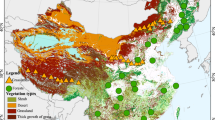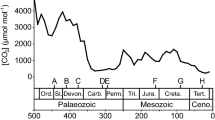Abstract
Key message
Stomatal area is proportional to the product of stomatal length and width with a proportionality coefficient exceeding π/4 (indicating a deviation from an elliptical shape) for four Magnoliaceae species.
Abstract
Stomatal size is an important factor affecting the photosynthetic and transpiration rates of vascular plants. To examine stomatal morphometrics, we measured the length (L), width (W), and area (A) of 960 stomata from four Magnoliaceae species within two genera (Magnolia and Michelia). Four mathematical models were used to estimate A: (i) A scales as a function of LW, which is referred to as the Montgomery equation (denoted as ME), (ii) A scales as a function of some power of LW, (iii) A scales as a function of L2, and (iv) A scales as some power of L. The data show that ME is the best among the four models based on the trade-off between the goodness of fit and model structural complexity, i.e., A is proportional to LW. The ME was verified at the species level and for the pooled data. The proportionality coefficient of ME was affected by stomatal geometry and exceeded the proportionality coefficient predicted for an elliptical shape of stomata (π/4). This study provides a simple and relatively accurate method for measuring stomatal area (e.g., it decreases by 40.1% the root-mean-square error when calculating A using π/4 × LW). In addition, the proportionality coefficient of ME also provides a useful quantitative taxonomic parameter and a method to gauge the response of plants to environmental changes.






Similar content being viewed by others
References
Baxes GA (1994) Digital image processing: principles and applications. John Wiley and Sons Inc, New York, NY
Beerling DJ, Royer DL (2002) Reading a CO2 signal from fossil stomata. New Phytol 153:387–397. https://doi.org/10.1046/j.0028-646x.2001.00335.x
Berry JA, Beerling DJ, Franks PJ (2010) Stomata: key players in the earth system, past and present. Curr Opin Plant Biol 13:232–239. https://doi.org/10.1016/j.pbi.2010.04.013
Bertolino LT, Caine RS, Gray JE (2019) Impact of stomatal density and morphology on water-use efficiency in a changing world. Front Plant Sci 10:225. https://doi.org/10.3389/fpls.2019.00225
Clark JW, Harris BJ, Hetherington AJ, Hurtado-Castano N, Brench RA, Casson S, Williams TA, Gray JE, Hetherington AM (2022) The origin and evolution of stomata. Curr Biol 32:R539–R553. https://doi.org/10.1016/j.cub.2022.04.040
Dong LX, Guan XL (2012) Characters of leaf epidermis and their systematic significance in genus Dianthus. Acta Botan Boreali-Occiden Sin 32:1155–1160. https://doi.org/10.3969/j.issn.1000-4025.2012.06.013
Dow GJ, Bergmann DC, Berry JA (2014) An integrated model of stomatal development and leaf physiology. New Phytol 201:1218–1226. https://doi.org/10.1111/nph.12608
Efron B, Tibshirani RJ (1993) An introduction to the bootstrap. Chapman and Hall/CRC, New York
Franks PJ, Beerling DJ (2009) Maximum leaf conductance driven by CO2 effects on stomatal size and density over geologic time. Proc Natl Acad Sci USA 106:10343–10347. https://doi.org/10.1073/pnas.0904209106
Gray A, Liu L, Facette M (2020) Flanking support: how subsidiary cells contribute to stomatal form and function. Front Plant Sci 11:881. https://doi.org/10.3389/fpls.2020.00881
Haworth M, Marino G, Materassi A, Raschi A, Scutt CP, Centritto M (2023) The functional significance of the stomatal size to density relationship: Interaction with atmospheric [CO2] and role in plant physiological behavior. Sci Total Environ 863:160908. https://doi.org/10.1016/j.scitotenv.2022.160908
He JY, Reddy GVP, Liu MD, Shi PJ (2020) A general formula for calculating surface area of the similarly shaped leaves: Evidence from six Magnoliaceae species. Global Ecol Conservat 23:e01129. https://doi.org/10.1016/j.gecco.2020.e01129
Hsu P (1996) Multiple comparisons: Theory and methods. Chapman and Hall/CRC, New York, NY
Huang WW, Li YY, Niklas KJ, Gielis J, Ding YY, Cao L, Shi PJ (2020) A superellipse with deformation and its application in describing the cross-sectional shapes of a square bamboo. Symmetry-Basel 12:2073. https://doi.org/10.3390/sym12122073
Jatmika S, Purwanto A, Dwandaru WSB (2022) The effect of sound vibration towards the stomata pore area via edge detection analysis. Rev Mex Fis 68:051402. https://doi.org/10.31349/RevMexFis.68.051402
Jiao YB, Gao ZP, Wang R (2021) Application of segregation process in observing the leaf stomatal structure of Michelia plants. Anhui Forestry Sci Technol 47(1):26–29. https://doi.org/10.3969/j.issn.2095-0152.2021.01.009
Jordan GJ, Carpenter RJ, Koutoulis A, Price A, Brodribb TJ (2015) Environmental adaptation in stomatal size independent of the effects of genome size. New Phytol 205:608–617. https://doi.org/10.1111/nph.13076
Kollist H, Nuhkat M, Roelfsema MRG (2014) Closing gaps: linking elements that control stomatal movement. New Phytol 203:44–62. https://doi.org/10.1111/nph.12832
Lawson T (2009) Guard cell photosynthesis and stomatal function. New Phytol 181:13–34. https://doi.org/10.1111/j.1469-8137.2008.02685.x
Lawson T, Vialet-Chabrand S (2019) Speedy stomata, photosynthesis and plant water use efficiency. New Phytol 221:93–98. https://doi.org/10.1111/nph.15330
Li XL, Zhang TR, Sun FB, Song XM, Zhang YK, Huang F, Yuan CY, Yu H, Zhang GH, Qi F, Shao F (2021) The relationship between particulate matter retention capacity and leaf surface micromorphology of ten tree species in Hangzhou China. Sci Total Environ 771:144812. https://doi.org/10.1016/j.scitotenv.2020.144812
Li YP, Quinn BK, Niinemets Ü, Schrader J, Gielis J, Liu MD, Shi PJ (2022) Ellipticalness index - a simple measure of the complexity of oval leaf shape. Pak J Bot 54:2233–2240. https://doi.org/10.30848/PJB2022-6(44)
Liu L, Hao LH, Zhang YX, Zhou HR, Ma BG, Cheng Y, Tian YS, Chang ZJ, Zheng YP (2022) The CO2 fertilization effect on leaf photosynthesis of maize (Zea mays L.) depends on growth temperatures with changes in leaf anatomy and soluble sugars. Front Plant Sci 13:890928. https://doi.org/10.3389/fpls.2022.890928
Ma JZ, Niklas KJ, Liu LY, Fang ZD, Li YR, Shi PJ (2022) Tree size influences leaf shape but does not affect the proportional relationship between leaf area and the product of length and width. Front Plant Sci 13:850203. https://doi.org/10.3389/fpls.2022.850203
Montgomery EG (1911) Correlation studies in corn. Annual Report no 24. Agricultural Experimental Station, Lincoln, NB, pp 108–159
Paek KY, Jun ES (1995) Stomatal density, size and morphological characteristics in orchids. J Korean Soc Sci 36:851–862
R Core Team (2022) R: a language and environment for statistical computing. R Foundation for Statistical Computing, Vienna, Austria. http://www.r-proje ct.org/
Sandhu HS, Shi PJ, Kuang XJ, Xue FS, Ge F (2011) Applications of the bootstrap to insect physiology. Florida Entomolog 94:1036–1041. https://doi.org/10.1653/024.094.0442
Schrader J, Shi PJ, Royer DL, Peppe DJ, Gallagher RV, Li YR, Wang R, Wright IJ (2021) Leaf size estimation based on leaf length, width and shape. Ann Bot 128:395–406. https://doi.org/10.1093/aob/mcab078
Shaheen S, Fateh R, Younis S, Harun N, Jaffer M, Hussain K, Ashfaq M, Siddique R, Mukhtar H, Khan F (2020) Light and scanning electron microscopic characterization of thirty endemic Fabaceae species of district Lahore. Pakistan Microsc Res Techniq 83:1507–1529. https://doi.org/10.1002/jemt.23545
Shi PJ, Ratkowsky DA, Li Y, Zhang LF, Lin SY, Gielis J (2018) A general leaf area geometric formula exists for plants − Evidence from the simplified Gielis equation. Forests 9:714. https://doi.org/10.3390/f9110714
Shi PJ, Liu MD, Ratkowsky DA, Gielis J, Su JL, Yu XJ, Wang P, Zhang LF, Lin ZY, Schrader J (2019) Leaf area-length allometry and its implications in leaf shape evolution. Trees-Struct Funct 33:1073–1085. https://doi.org/10.1007/s00468-019-01843-4
Shi PJ, Gielis J, Quinn BK, Niklas KJ, Ratkowsky DA, Schrader J, Ruan HH, Wang L, Niinennets U (2022) “biogeom”: An R package for simulating and fitting natural shapes. Ann N Y Acad Sci 1516:123–134. https://doi.org/10.1111/nyas.14862
Su JL, Niklas KJ, Huang WW, Yu XJ, Yang YY, Shi PJ (2019) Lamina shape does not correlate with lamina surface area: an analysis based on the simplified Gielis equation. Global Ecol Conservat 19:e00666. https://doi.org/10.1016/j.gecco.2019.e00666
Thompson DW (1917) On growth and form. Cambridge University Press, London
Tian F, Wang YJ, Sandhu HS, Gielis J, Shi PJ (2020) Comparison of seed morphology of two ginkgo cultivars. J Forest Res 31:751–758. https://doi.org/10.1007/s11676-018-0770-y
Wu GL, Liu H, Hua L, Luo Q, Lin YX, He PC, Feng SW, Liu JX, Ye Q (2018) Differential responses of stomata and photosynthesis to elevated temperature in two co-occurring subtropical forest tree species. Front Plant Sci 9:467. https://doi.org/10.3389/fpls.2018.00467
Xiong DL, Flexas J (2020) From one side to two sides: the effects of stomatal distribution on photosynthesis. New Phytol 228:1754–1766. https://doi.org/10.1111/nph.16801
Yang XX, Yang Y, Ji CJ, Feng T, Shi Y, Lin L, Ma JJ, He JS (2014) Comparative chloroplast genomes of six Magnoliaceae species provide new insights into intergeneric relationships and phylogeny. Basic Appl Ecol 15:122–132. https://doi.org/10.1016/j.baae.2014.01.003
Yang L, Tian JH, Xu L, Zhao XL, Song YY, Wang DW (2022) Comparative chloroplast genomes of six Magnoliaceae species provide new insights into intergeneric relationships and phylogeny. Biology 11:1279. https://doi.org/10.3390/biology11091279
Yu XJ, Shi PJ, Schrader J, Niklas KJ (2020) Nondestructive estimation of leaf area for 15 species of vines with different leaf shapes. Am J Bot 107:1481–1490. https://doi.org/10.1002/ajb2.1560
Yu KX, Reddy GVP, Schrader J, Guo XC, Li YR, Jiao YB, Shi PJ (2022) A nondestructive method of calculating the wing area of insects. Ecol Evolut 12:e8792. https://doi.org/10.1002/ece3.8792
Zhu JY, Yu Q, Xu CY, Li JH, Qin GM (2018) Rapid estimation of stomatal density and stomatal area of plant leaves based on object-oriented classification and its ecological trade-off strategy analysis. Forests 9:616. https://doi.org/10.3390/f9100616
Acknowledgements
The authors are thankful to Xuchen Guo, Yaobing Jiao, Xingjian Liu, Lin Wang and Yufeng Yang for their valuable help during the preparation of this work.
Funding
The authors have not disclosed any funding.
Author information
Authors and Affiliations
Corresponding author
Ethics declarations
Conflict of interest
The authors declare that they have no conflict of interest.
Additional information
Communicated by Takayoshi KOIKE.
Publisher's Note
Springer Nature remains neutral with regard to jurisdictional claims in published maps and institutional affiliations.
Supplementary Information
Below is the link to the electronic supplementary material.
Rights and permissions
Springer Nature or its licensor (e.g. a society or other partner) holds exclusive rights to this article under a publishing agreement with the author(s) or other rightsholder(s); author self-archiving of the accepted manuscript version of this article is solely governed by the terms of such publishing agreement and applicable law.
About this article
Cite this article
Zhang, L., Niklas, K.J., Niinemets, Ü. et al. Stomatal area estimation based on stomatal length and width of four Magnoliaceae species: even “kidney”-shaped stomata are not elliptical. Trees 37, 1333–1342 (2023). https://doi.org/10.1007/s00468-023-02425-1
Received:
Accepted:
Published:
Issue Date:
DOI: https://doi.org/10.1007/s00468-023-02425-1




